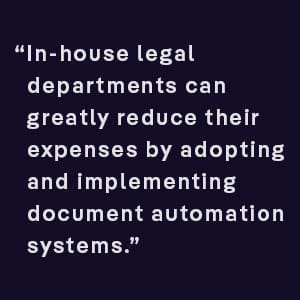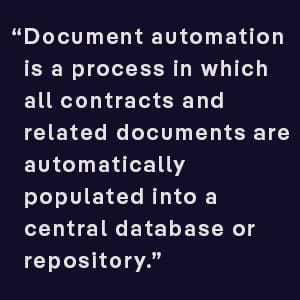At any given time, the average Fortune 2000 company holds between 20,000 and 40,000 active contracts. And yet, the majority of corporate legal departments continue to manage their agreements and related documents without the help of legal automation.
But by adopting end-to-end document automation systems, in particular, in-house legal departments and organizations can move away from manual document review. They can reduce the common errors and high costs associated with present contract lifecycle management.
The following is a convenient overview of documentation automation, in general, and a breakdown of the benefits of such legal technology solutions, in particular.
What Are Document Automation Systems?
Typically speaking, document automation is a process in which all contracts and related documents are automatically populated into a central database — or repository. This is really the first step in significantly reducing the time and effort put into contract review. Document automation systems then use data and other information contained in a legal document, placing important contractual details into a database for easy use and reference.
Ultimately, this kind of technology offers many advantages to corporate legal departments and companies. Here are just a couple:
Increased Productivity
In-house legal teams can spend countless hours typing out and processing legal documents in the absence of legal tech. In fact, according to The American Lawyer, it can take up to 92 minutes to review a typical agreement. But this manual contracting is not only slow and inefficient but also potentially ineffective.
By automating the processing of legal documents, however, corporate counsels can speed up this part of the contract lifecycle and perhaps spend more time on higher-value projects.
Reduced Errors and Costs
Let’s face it, reviewing contracts with the human eye can be extremely tedious. However, this manual process can also be quite prone to error. World Commerce & Contracting (World CC) even estimates that poor contract management leads to a 9.2 percent loss in annual revenue in the average company.
In-house legal departments can greatly reduce their expenses, though, by adopting and implementing document automation systems, and digitizing agreements, and streamlining their overall management. What is more, money and resources that would normally be spent on manual document review can be used on other functions — in other parts of the enterprise. Just as a side note, nearly half of all legal departments interviewed by Gartner in 2019 revealed that their own legal automation technology resulted in a greater-than-expected return on investment (ROI). Just take that in for a moment.
Are You Ready for an End-to-end Document Automation System?
So, isn’t it time your in-house legal team embraces legal digital transformation? Are you ready to adopt and implement the latest legal tech — in the form of end-to-end document automation systems? After all, the development and deployment of this solution will only continue to speed up, along with the digital evolution of your competitors. This, as your own business priorities continue to shift, your workloads rapidly increase, and your contracts become more and more complex.
To find the right legal technology and document automation system for your company, download the “How to Choose a Contract Management Solution whitepaper”. Or talk to one of our contract management experts today!
Author:

Sarvarth Misra
Connect with us on Linkedin











